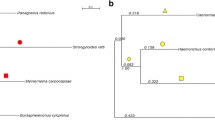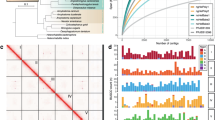Abstract
During parasitization of their hosts some insect parasitoids deliver resident viruses which encode genes that must be expressed in the host for successful parasitization. Among these viruses the Campoletis sonorensis Ichnovirus has been well studied and encodes a cys-motif gene family implicated in disruption of host immunity and other physiological systems. Members of this gene family encode one or more intercystine-knot structural motifs in which the non-cysteine residues of the motif are variable. We analyzed patterns of synonymous and non-synonymous substitution within the cys-motif to investigate the evolution of this gene family and the likelihood of virus-host gene coevolution. Maximum likelihood techniques suggest positive selection acts on 8 of 51 codons in the aligned cysteine-rich region. Although the detected positive selection was not strong, it likely contributes to the diversification of this gene family. Comparison of selection pressure relative to tertiary structure of the VHv1.1 cys-motif protein suggests that the hypervariable sites are exposed. Furthermore, invariant residues in the motif exhibit a region-specific pattern of codon bias, suggesting there are unusual mechanisms of effecting selection pressure at work in this system, though the mechanism has yet to be studied. The positive selection and duplication of both the gene family and the cys-motif implies either selection is driving the molecular radiation of immune suppressive genes toward novel hosts, or molecular coevolution with host targets.






Similar content being viewed by others
References
Bielawski JP, Dunn KA, Yang Z (2000) Rates of nucleotide substitution and mammalian nuclear gene evolution. Approximate and maximum-likelihood methods lead to different conclusions. Genetics 156:1299–1308
Blissard GW, Smith OP, Summers MD (1987) Two related viral genes are located on a single superhelical DNA segment of the multipartite Campoletis sonorensis virus genome. Virology 160:120–134
Conticello SG, Gilad Y, Avidan N, Ben-Asher E, Levy Z, Fainzilber M (2001) Mechanisms for evolving hypervariability: the case of conopeptides. Mol Biol Evol 18:120–131
Corpet F (1988) Multiple sequence alignment with hierarchical clustering. Nucleic Acids Res 16:10881–10890
Craig AG (2000) The characterization of conotoxins. J Toxicol Toxin Rev 19:53–93
Cui L, Webb BA (1996) Isolation and characterization of a member of the cysteine-rich gene family from Campoletis sonorensis polydnavirus. J Gen Virol 77:797–809
Cui L, Webb BA (1997) Homologous sequences in the Campoletis sonorensis polydnavirus genome are implicated in replication and nesting of the W segment family. J Virol 71:8504–8513
Cui L, Soldevila A, Webb BA (1997) Expression and hemocyte-targeting of a Campoletis sonorensis polydnavirus cysteine-rich gene in Heliothis virescens larvae. Arch Insect Biochem Physiol 36:251–271
Cui L, Soldevila AI, Webb BA (2000) Relationships between polydnavirus gene expression and host range of the parasitoid wasp Campoletis sonorensis. J Insect Physiol 46:1397–1407
Dahlman DL, Scheppers EL, Scheppers T, Rana RL, DiLuna FA, Webb BA (2003) A gene from a parasitic wasp expressed in teratocytes inhibits host protein synthesis, growth and development. Insect Molecular Biology (in press)
Daquinag AC, Sato T, Koda H, Takao T, Fukuda M, Shimonishi Y, Tsukamoto T (1999) A novel endogenous inhibitor of phenoloxidase from Musca domestica has a cystine motif commonly found in snail and spider toxins. Biochem 38:2179–2188
Deng L, Stoltz DB, Webb BA (2000) A gene encoding a polydnavirus structural polypeptide is not encapsidated. Virology 269:440–450
Dib-Hajj SD, Webb BA, Summers MD (1993) Structure and evolutionary implications of a "cysteine-rich" Campoletis sonorensis polydnavirus gene family. Proc Natl Acad Sci USA 90:3765–3769
Dowton M, Austin AD (1994) Molecular phylogeny of the insect order Hymenoptera: Apocitan relationships. Proc Natl Acad Sci USA 91:9911–9915
Dupas S, Carton Y (1999) Two non-linked genes for specific virulence of Leptopilina boulardi against Drosophila melanogaster and D. yakubu. Evol Ecol 13:211–220
Einerwold J, Jaseja M, Hapner K, Webb B, Copie VV (2001) Solution Structure of the carboxyl-terminal cysteine-rich domain of the VHv1.1 polydnaviral gene product: comparison with other cystine knot structural folds. Biochemistry 40:14404–14412
Fleming JG, Summers MD (1991) Polydnavirus DNA is integrated in the DNA of its parasitoid wasp host. Proc Natl Acad Sci USA 88:9770–9774
Gruber A, Stettler P, Heiniger P, Schumperli D, Lanzrein B (1996) Polydnavirus DNA of the braconid wasp Chelonus inanitus is integrated in the wasp's genome and excised only in later pupal and adult stages of the female. J Gen Virol 77:2873–2879
Hawkins BA, Cornel HV, Hochberg ME (1997) Predators, parasitoids, and pathogens as mortality agents in phytophagous insect populations. Ecology 78:2145–2152
Hughes AL, Ota T, Nei M (1990) Positive Darwinian selection promotes charge profile diversity in the antigen-binding cleft of class I major-histocompatibility-complex molecules. Mol Biol Evol 7:515–524
Kraaijeveld AR, Godfray HCJ (2001) Is there local adaptation in Drosophila-parasitoid interactions? Evol Ecol Res 3:107–116
Lavine MD, Strand MR (2001) Surface characteristics of foreign targets that elicit an encapsulation response by the moth Pseudoplusia includens. J Insect Physiol 47:965–974
Li W-H (1997) Molecular evolution. Sinauer, Sunderland, Mass., pp 487
Li X, Webb BA (1994) Apparent functional role for a cysteine-rich polydnavirus protein in suppression of the insect cellular immune response. J Virol 68:7482–7489
Lo Conte L, Chothia C, Janin J (1999) The atomic structure of protein-protein recognition sites. J Mol Biol 285:2177–2198
Miyata T, Yasunaga T (1980) Molecular evolution of mRNA: a method for estimating evolutionary rates of synonymous and amino acid substitutions from homologous nucleotide sequences and its application. J Mol Evol 16:23–36
Nei M, Gojobori T (1986) Simple methods for estimating the numbers of synonymous and nonsynonymous nucleotide substitutions. Mol Biol Evol 3:418–426
Norton RS, Pallaghy PK (1998) The cystine knot structure of ion channel toxins and related polypeptides. Toxicon 36:1573–1583
Pallaghy PK, Nielsen KJ, Craik DJ, Norton RS (1994) A common structural motif incorporating a cystine knot and a triple-stranded beta-sheet in toxic and inhibitory polypeptides. Protein Sci 3:1833–1839
Sambrook J, Fritsch EF, Maniatis T (1989) Molecular cloning: a laboratory manual, 2nd edn. Cold Springs Harbor Laboratory Press, Cold Spring Harbor, NY
Savary S, Drezen JM, Tan F, Beckage NE, Periquet G (1999) The excision of polydnavirus sequences from the genome of the wasp Cotesia congregata (Braconidae, microgastrinae) is developmentally regulated but not strictly restricted to the ovaries in the adult. Insect Mol Biol 8:319–327
Stoltz DB, Whitfield JB (1992) Viruses and virus-like entities in the parasite Hymenoptera. J Hymen Res 1:125–139
Stoltz DB, Xu D (1990) Polymorphism in polydnavirus genomes. Can J Microbiol 36:538–543
Suzuki Y, Gojobori T (1999).A method for detecting positive selection at single amino acid sites. Mol Biol Evol 16:1315–1328
Suzuki Y, Nei M (2002) Simulaton study of the reliability and robustness of the statistical methods for detecting positive selection at single amino acid sites. Mol Biol Evol 11:1865–1869
Turnbull MW, Webb BA (2002) Perspectives on polydnavirus origins and evolution. Adv Virus Res 58:203–254
Volkoff A, Ravallec M, Bossy J, Cerutti P, Rocher J, Cerutti M, Devauchelle G (1995) The replication of Hyposoter didymator polydnavirus: cytopathology of the calyx cells in the parasitoid. Biol Cell 83:1–13
Yang Z, Bielawski JP (2000. Statistical methods for detecting molecular adaptation. Trends Evol Ecol 15:496–503
Yang Z, Nielsen R, Goldman N, Pedersen AM (2000a) Codon-substitution models for heterogeneous selection pressure at amino acid sites. Genetics 155:431–449
Yang Z, Swanson WJ, Vacquier VD (2000b) Maximum-likelihood analysis of molecular adaptation in abalone sperm lysin reveals variable selective pressures among lineages and sites. Mol Biol Evol 17:1446–1455
Acknowledgements
We thank Dr. Austin Hughes for his communications and SCR3 software. We also thank Prof. Yves Carton and Dr. Mike Sharkey for their constructive discussions, Dr. David Wahl for supplying most identified specimens, Prof. Ziheng Yang for his pioneering work on the subject and Dr. Valerie Copie for donation of the coordinates for the VHv1.1 structure. This work was partially supported by an NSF grant to BAW (MCB 0094403) and is publication 03-08-079 of the Kentucky Experiment Station.
Author information
Authors and Affiliations
Corresponding author
Additional information
Novel nucleotide sequence data reported are available in the DDBJ/EMBL/GenBank databases under the accession numbers AY033945, AY197489, AY197490, AY197491, AY197492, AY197493 and AY197494
Rights and permissions
About this article
Cite this article
Dupas, S., Turnbull, M.W. & Webb, B.A. Diversifying selection in a parasitoid's symbiotic virus among genes involved in inhibiting host immunity. Immunogenetics 55, 351–361 (2003). https://doi.org/10.1007/s00251-003-0595-4
Received:
Accepted:
Published:
Issue Date:
DOI: https://doi.org/10.1007/s00251-003-0595-4




